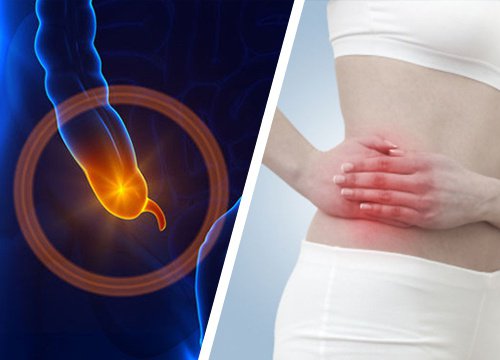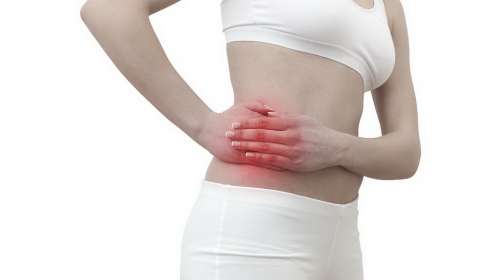Crucial Appendicitis Symptoms That You Should Recognize


Written and verified by psychologist Valeria Sabater
A lot of people who get appendicitis require urgent intervention, so for medical emergencies like this one, it’s always a good idea to be able to recognize the symptoms and be on alert.
But… what causes this to happen? It’s usually due to inflammation of the appendix, that small organ right at the start of your large intestine.
It affects children as well as adults, so in today’s article, we want to help you recognize common appendicitis symptoms and hints that might indicate a possible case of appendicitis.
Find out more with us.
Read also: 6 Common Diseases during Pregnancy
Appendicitis symptoms
 1. Type of pain
1. Type of pain
- Pain usually starts in the center of the abdomen near the navel, but gradually “radiates” out to the lower right abdomen, a little above your hipbone.
- When you press on that region, the pain becomes more intense and acute and can feel unbearable.
- Your stomach will seem hard. You might have a strange sense of being “full,” and when you press on the abdomen it’s unusually firm. What causes this? Inflammation of the intestine can occur when the appendix is infected, causing serious problems.
- Perhaps you will feel a sharp pain in your hip when walking. It will only occur on the right side.
- The only time you’ll notice any real relief is when you lie down, but it’s usually only momentary.
- Try coughing. If you notice sharp pain or a burning sensation in your abdomen, it’s a clear sign that there’s some inflammation in the belly region: possibly from your appendix.
- Bear in mind that if you are experiencing these symptoms, you may only have between 12 and 24 hours before they become more severe and you need to be admitted to a hospital. Above all, pay close attention to children with these symptoms. Even if you only have the smallest indication, it’s best that you see a doctor and let them make the correct diagnosis.
2. Secondary symptoms that accompany the abdominal pain
- Fever. This is an important one. If you’re having discomfort on your right side that’s accompanied by even a few tenths of a degree higher than normal temperature, go to the doctor immediately.
- Constipation. An infected appendix almost always causes some kind of disruption in the small intestine. It’s not uncommon the experience bouts of constipation, and by straining to use the bathroom you might trigger even stronger pain in the abdomen.
- Loss of appetite. You’ll feel uncomfortably full and will want to eat less. Another common symptom is excess gas that you’re unable to release, which further compounds that feeling of “fullness.” It can be very frustrating.
- Vomiting, general malaise, and fatigue are a few other symptoms that also frequently accompany appendicitis. These might even appear a few days before the abdominal pain becomes unbearable and forces you to head to the emergency room. They’re worth taking into account.
Read also: 8 Signs of Cardiac Diseases that Should Not Be Overlooked
But…what causes appendicitis?

- Hyperplasia of lymphoid follicles: the name may sound complicated but it’s easy enough to understand. This is similar to what happens to the tonsils in your throat. Those organs have an important role in the body, but when they get inflamed they swell and obstruct the throat while causing an infection and a fever. Such infections especially tend to occur between 8 and 30 years old, and this is the age group that’s also most at risk for appendicitis.
- Waste and toxins. Sometimes the part of the intestine near the appendix builds up solid waste from improper elimination. It can become obstructed or infected, and as a result, the normal intestinal flow is disrupted. People who frequently suffer from constipation have a higher risk of appendicitis as well. Eventually, the intestine becomes inflamed and infected, and you should be careful because this can lead to dangerous peritonitis.
- Inflammation. The walls of the appendix are lined with very small lymphoid follicles. As we said above, it’s similar to the tonsils. Sometimes an illness or even something you eat can cause bacteria to grow and stick to those follicles, infecting them. This is very common because remember that there’s a lot of harmful bacteria in the gut that can trigger infection and therefore appendicitis.
Also…
Don’t forget that it’s important to take good care of your diet.
That doesn’t mean you can avoid ever having appendicitis by eating well, but you can at least reduce your probability of it happening to you.
Detox your body regularly and avoid suffering from constipation. This is essential to your overall health.
Drink lots of fluids, eat plenty of fiber, vegetables, and fresh fruit – and don’t miss out on the benefits of probiotics.
Foods like Greek yogurt and kefir help promote good bacteria that can protect against infection.
Another thing you should not forget is a glass of warm water with lemon juice every morning.
It helps cleanse the body and remove toxins while providing you with essential vitamins to start your day.
Did you have any of these appendicitis symptoms?
All cited sources were thoroughly reviewed by our team to ensure their quality, reliability, currency, and validity. The bibliography of this article was considered reliable and of academic or scientific accuracy.
- Adamidis, E. Roma-Giannikou, K. Karamolegou, E. Tselalidou, A. Constantopoulos, D. (2000). Fiber intake and childhood appendicitis. International journal of food sciences and nutrition, 51(3), 153-157. Available at: https://doi.org/10.1080/09637480050029647. Accessed 30/03/2020.
- Gibson, G. R. (2004). From probiotics to prebiotics and a healthy digestive system. Journal of food Science, 69(5), M141-M143. Available at: https://doi.org/10.1111/j.1365-2621.2004.tb10724.x. Accessed 30/03/2020.
- Humes, D. J., & Simpson, J. (2006). Acute appendicitis. Bmj, 333(7567), 530-534. Available at: https://doi.org/10.1136/bmj.38940.664363.AE. Accessed 30/03/2020.
- Petroianu, A. (2012). Diagnosis of acute appendicitis. International Journal of Surgery, 10(3), 115-119. Available at: https://doi.org/10.1016/j.ijsu.2012.02.006. Accessed 30/03/2020.
- Raahave, D. (2010). Faecal retention: A common cause in functional bowel disorders, appendicitis and haemorrhoids. J Gastroenterol, 45, 592-602. Available at: https://www.researchgate.net/profile/Dennis_Raahave/publication/273325152_Faecal_retention_a_common_cause_in_functional_bowel_disorders_appendicitis_and_haemorrhoids–with_medical_and_surgical_therapy/links/588746ec92851c21ff5159be/Faecal-retention-a-common-cause-in-functional-bowel-disorders-appendicitis-and-haemorrhoids–with-medical-and-surgical-therapy.pdf. Accessed 30/03/2020.
- Vilela Desposorio, C. D., & Cusma Quintana, T. N. (2015). Asociación entre la obstrucción apendicular y el tipo morfológico de apendicitis aguda. Revista de Gastroenterología del Perú, 35(1), 32-37. Available at: http://www.scielo.org.pe/scielo.php?script=sci_arttext&pid=S1022-51292015000100004. Accessed 30/03/2020.
- Villa, D. D. C. (2011). Histopatología de las apendicitis agudas-necrosis versus apoptosis. Morfolia, 3(4). Available at: http://bdigital.unal.edu.co/28092/1/26032-91243-1-PB.pdf. Accessed 30/03/2020.
This text is provided for informational purposes only and does not replace consultation with a professional. If in doubt, consult your specialist.








